At the end of November Wine Lister spent three days in Burgundy meeting with producers across the length of the Côte d’Or. With more wine in their barrel cellars than for a very long time (in some cases more than ever), the mood was light and easy. The 2017 vintage saw the first normal-sized crop since 2009 (and 2018 was even more generous). “It’s the first year we’ve had barrels three rows high,” marvelled Thibaut Gagey as he showed me round Maison Louis Jadot’s vast cellars in Beaune, currently housing a record 6,000 fûts.
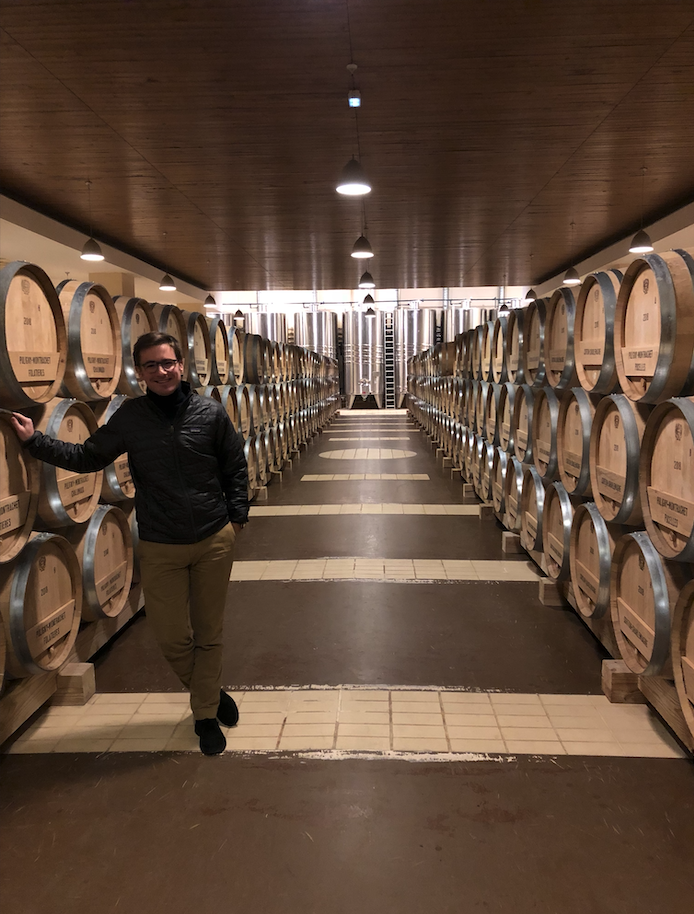
Thibaut Gagey in the Maison Louis Jadot cellars
The 2017 vintage is a “belle surprise” for Gagey, who admits, “we weren’t very confident at first.” This pleasant surprise was something expressed time and again by growers during our tastings of 2017 from barrel. With Burgundy Week about to unfold, here we look back over some of those conversations.
In Volnay, Guillaume d’Angerville calls the 2017 “a huge positive surprise.” He explained that “a lot of people had discounted the vintage early on,” because “they thought it would be diluted.” Our tastings, at Domaine d’Angerville and elsewhere, proved this supposition to be mistaken, the wines having taken on weight and complexity during their élevage. Jasper Morris MW refers to 2017 wines as “relatively homogenous, some with more concentration and others with less.” Either way, the wines are juicy, luminous, and downright delightful.
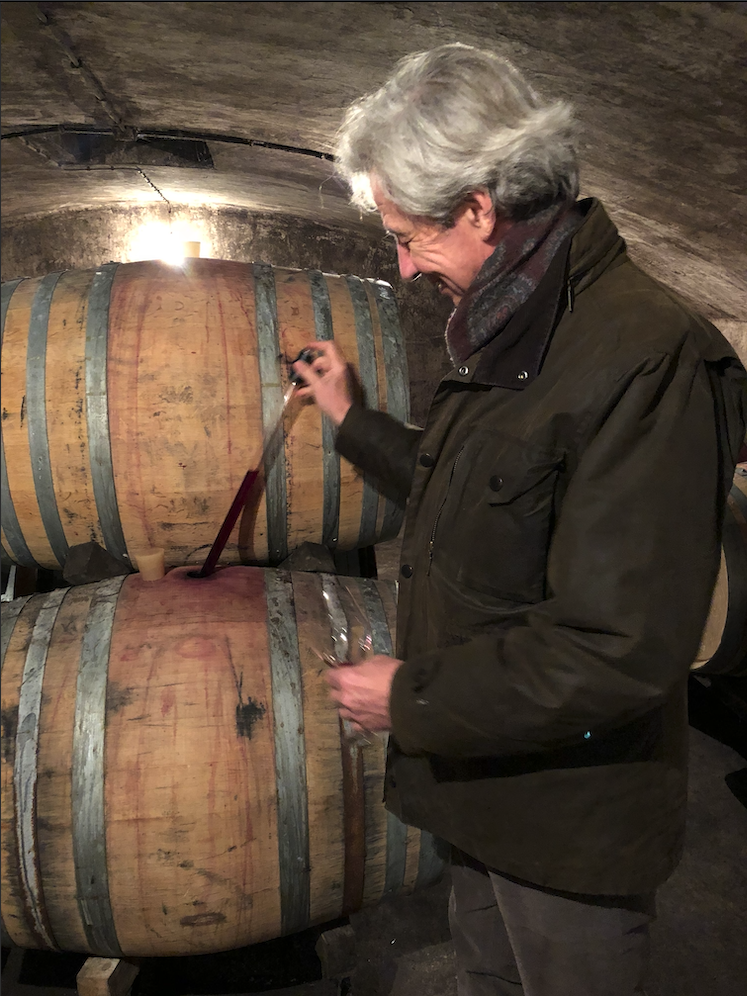
Tasting from barrel with Guillaume d’Angerville
Boris Champy, Manager at Domaine des Lambrays, calls the vintage both “classic” and “modern” at once, because he believes there’ll be many like it in the future. He compared 2017 to 2009. Angerville is reminded of the “tenderness” of 2007 (“but more substantial”) and the “harmony and elegance” of 2002 or 2010. “It’s going to give a lot of pleasure,” he pronounced. Gagey also cited 2007 for its positive surprise factor, and 2014 for its “accessibility”. The immediate pleasure these wines offer up is almost disconcerting, but this early approachability does not mean they won’t age. The 2017 might not be the longest-lived vintage, but it has everything in place for a good innings.
However, it “won’t be the vintage of the century,” Gagey states. “What it doesn’t have is that extra grip, depth, and drive of a great vintage,” confirms Morris. Meanwhile, the whites are superlative. “Apart from 2014,” Morris calls it the “most consistently good white vintage for a long time.”
The growing season was early, but otherwise unexceptional, apart, of course, from the threat of frost once more rearing its ugly head. This time, though, the Burgundians fought their nemesis with a thick veil of smoke. The fires they lit around their vineyards may have served to raise the temperature a fraction, but just as importantly, their smoke prevented the morning sun being magnified through the ice and burning the buds. And so, apart from in Chablis, yields were back to normal levels.
One might assume therefore that prices will come down – after all, the consistent increases over the last eight years have been put down to limited supply. This would be naïve, though, with global demand and secondary market values for Burgundy’s top wines continuing to spiral upwards, even to the bewilderment of some Burgundians (after the record-breaking results of the latest Hospices de Beaune auction of 2018 wines in November, Louis-Fabrice Latour, president of the BIVB (Bureau interprofessionnel des vins de Bourgogne), said he was “surprised prices went up, and by so much”).
The fact is, momentum is with Burgundy. The region’s top 50 wines grew in popularity by 26% over the last year, while Bordeaux’s search rank on Wine-Searcher remained stable, and other regions saw search levels drop. This means that top producers can almost certainly raise prices again this year and still sell through. We spoke to a few domaines who planned to do so, and some by significant margins. Mostly, though, prices should be flat on 2016 or see only modest increases (less than 10% up on 2016 prices). A minority have even come down in price. Either way, this is surely a vintage worth getting your hands on for unadulterated drinking pleasure.
Wine Lister’s Burgundy Market Study published this time last year for subscribers is now free for all to read. Download it in English or in French.
Wine Lister’s Founding Members’ tasting (the second if its kind) was held last week in the most beautiful surroundings at Ten Trinity Square Private Club. Aside from showcasing how Wine Lister data relates to the actual liquid in the bottle, these tastings are an opportunity to thank friends and supporters of Wine Lister, from subscribers to Founding Members.
We were excited to share news of upcoming developments with our guests, including the imminent expansion of Wine Lister’s coverage (almost doubling from the current 20,000 wines scored), as well as the addition of a new rating criterion. Watch this space!
Wine Lister’s Founding Members, more than 50 major players in the international wine trade, make an invaluable contribution to Wine Lister’s research by sharing their market insights with us on a biannual basis. It is Wine Lister’s role as a fine wine intelligence agency to combine this qualitative information with quantitative data to shed analytical light on fine wines from across the world, for example in our regional reports and factsheets.
In one recent trade survey we asked Founding Members the question, “Which wines do you consider hidden gems (wines you rate highly but which are under-appreciated)?”. The responses inspired the wonderfully varied (but consistently delicious) selection of 24 hidden gems tasted last Thursday (see the full list of wines below).
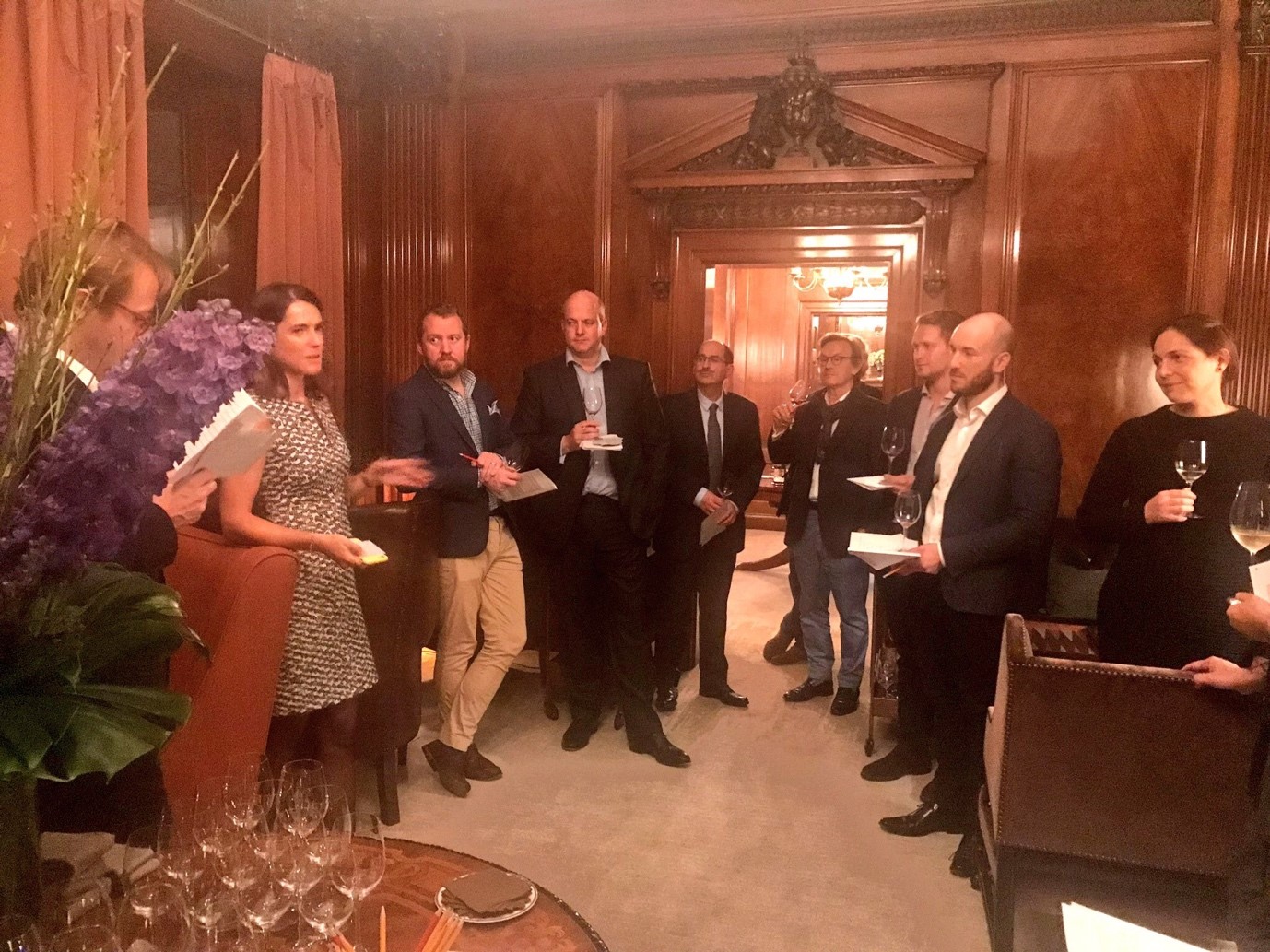
From left to right: Antoine Forterre, Ella Lister, Giles Cooper, Henry Donne, Pascal Kuzniewski, Pierre-Marie Boury, Anthony Vertadier Mabille, Gareth Kristensen, Sara Guiducci.
In an illustration of how Wine Lister brings together market research with hard data, the “raw” hidden gems selected by our Founding Members are then overlaid with critics’ ratings, restaurant presence, and search frequency data. This gives us the final Hidden Gems presented on the Wine Lister website. In other words, Hidden Gems are wines that are rarely found in top restaurants, and not often searched for online, but which receive high ratings from our partner critics, and have been singled out by our Founding Members as not garnering due attention.
The Founding Members’ “raw” hidden gems featured several Bordeaux wines, including 10 out of the 24 wines shown in the tasting. However, none of these achieve final Hidden Gem status due to their already established brands.
To liven up the evening, we encouraged guests to play “guess the score” – to see how closely they could estimate the Wine Lister score of the wines that they tasted. All the wines were showing beautifully, but Pichon Longueville Comtesse de Lalande 2005 was the wine that our guests successfully identified as having the highest Wine Lister score of the tasting, despite their guesses sitting an average 44 points below Pichon Comtesse 2005’s actual Wine Lister score of 931.
Conversely, Henschke Mount Edelstone Shiraz 2014, Pédesclaux 2014, and Louis Roederer Brut Premier were all awarded higher scores on average by our guests than their official Wine Lister ratings, but the biggest difference was for G.D. Vajra Barolo Albe 2013. It was awarded an average score of 746 by our guests, 73 points above its actual Wine Lister score, which is brought down by a very low Economics score of 124, due to very little price movement or liquidity. This illustrates how the data-driven elements of Wine Lister scores complement the tasting component.
The wine where our guests came closest with their guesses, just 10 points out, was Brane-Cantenac 2005, estimated at 840 compared to its real Wine Lister score of 850.
Congratulations to the game’s winner, Anneka Swann of BI Wines & Spirits, who was just 37 points out on average. We would also like to thank all our other guests for their valiant efforts at guessing the scores: Adam Brett-Smith, Andrea Frost, Chad Delaney, Charles Metcalfe, James Jackson-Nichols, Nicolas Clerc, Richard Stow, Rupert Millar, Tahir Sultan, and Will Hargrove.
Wines featured in the tasting: Louis Roederer Brut Premier, Philipponnat Clos de Goisses 2007, E. Guigal Condrieu La Doriane 2016, Casa Lapostolle Clos Apalta 2014, Seña 2010, Henschke Mount Edelstone Shiraz 2014, Isole e Olena Syrah Collezione Privata 2011, Tenuta San Guido Guidalberto 2016, Produttori del Barbaresco Barbaresco 2014, G.D. Vajra Barolo Albe 2013, G.D. Vajra Barolo Bricco delle Viole 2009, Domaine Duroché Gevrey-Chambertin Les Jeunes Rois 2015, Domaine Duroché Chambertin Clos de Bèze Grand Cru 2015, Domaine Tempier Cuvée Cabassou 2007, Château La Gaffelière 2014, Le Marquis de Calon Ségur 2014, Château Haut-Bailly La Parde 2012, Château Les Carmes Haut-Brion 2014, Château d’Issan 2011, Château Branaire-Ducru 2012, Château Pédesclaux 2014, Château Pichon Longueville Comtesse de Lalande 2005, Château Brane-Cantenac 2005, Château Lafon Rochet 2010.
The 2018 will be a five-star vintage for Chianti Classico wines according to Giovanni Manetti, newly-elected president of the appellation’s Consorzio. The growing season was “very regular”, with no extreme weather events, and normal picking times. Thanks to healthy grapes, ripe yet fresh, Manetti believes the vintage will be characterised by “harmony”. The DOCG appellation is set to produce c.270,000 hectolitres, back to normal production levels after a less abundant 2017.
On Monday 24th September at Fontodi, Manetti’s winery in Panzano, harvest was well underway. It had not rained for 22 days, and the ground was dusty. However, Manetti explained that in Panzano, while hot, temperatures had not risen above 36˚C, and that nights had been cool. At Castello di Fonterutoli, 15km further south, Giovanni Mazzei confirmed the heat had been nothing on 2015, when temperatures rose above 45˚C.
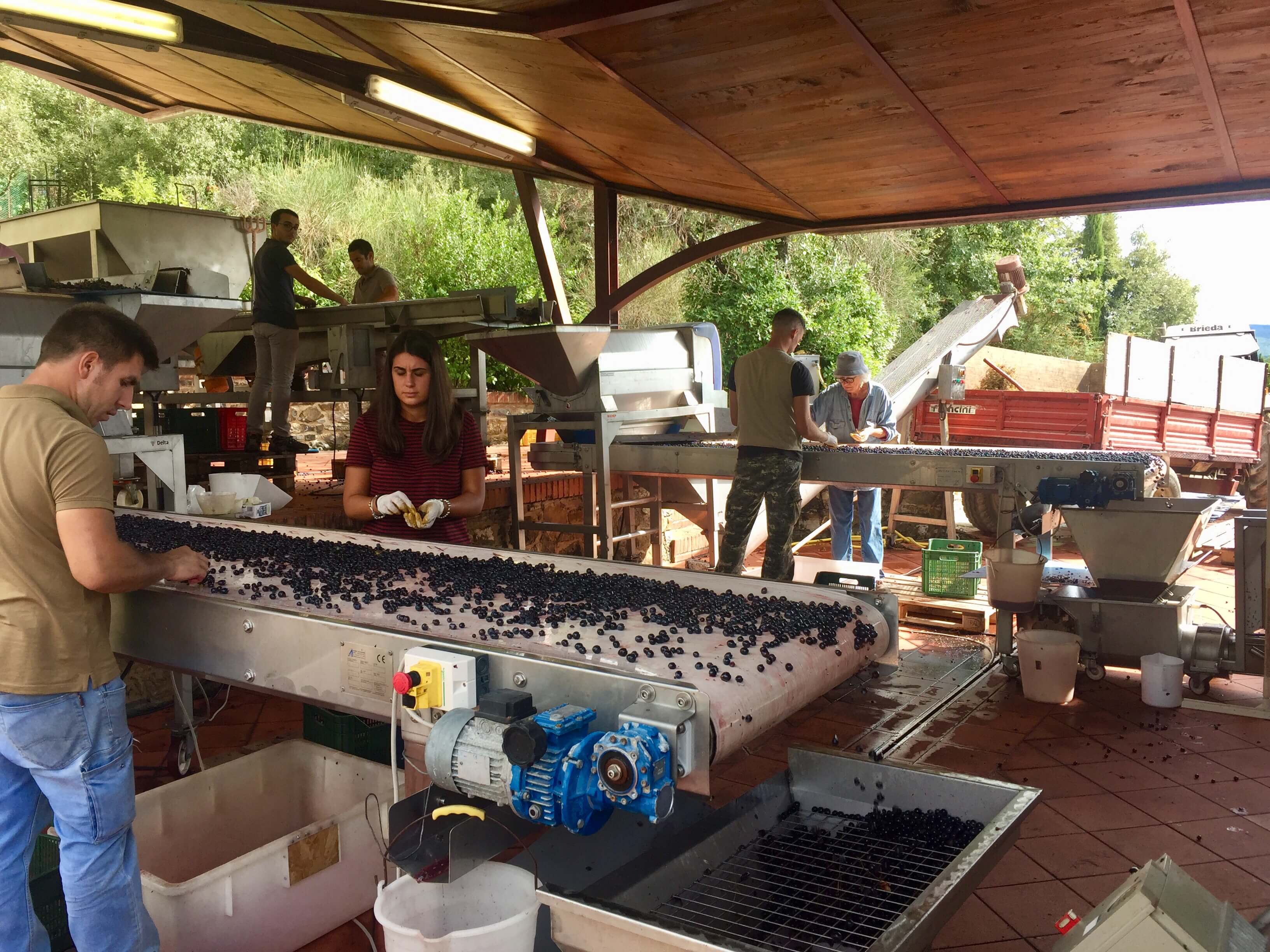
Quality control at Fontodi’s sorting tables in Chianti Classico
However, Mazzei was somewhat less sanguine about the 2018, citing humid mornings as a challenge. Having picked one third of the estate’s production by Monday, the next fortnight will be a race against rot. Mazzei predicts the vintage might fall between the opulent 2015s and the structured 2016s in terms of quality and style.
Towards the coast, in Bolgheri, the Merlot harvest is almost finished, and “the fermenting wines are silky and fragrant,” according to Axel Heinz, Estate Director at both Ornellaia and Masseto. Heinz is grateful for “excellent conditions during September with sunny and mostly dry weather, occasionally hot day temperatures but cool nights”. In Bolgheri, “mildew and humidity have been challenging,” he states, ”but we were able to bring healthy fruit to full ripeness,” recounts Heinz, who says yields in 2018 are normal. He predicts “a more delicate vintage, like 2013.”
Moving down the coast, in the Maremma, Elisabetta Geppetti, owner of Fattoria Le Pupille, spoke of regular climatic conditions leading to “a good year”. The first lot of Merlot for Geppetti’s flagship wine Saffredi is already vinified, and, she says, “marvellous”. She is delighted with her Cabernet Sauvignon too, and relayed the view of Le Pupille’s consultant oenologist Luca d’Attoma, that the grape has thrived throughout the whole southern part of Tuscany. Meanwhile Sangiovese has ripened less evenly.
Back inland, in Sangiovese’s heartland, Montalcino, the picture is less clear cut, due to excessive rain in spring and early summer. “Winemakers had not seen this kind of weather since the nineties,” explained Giacomo Pondini, Director of the Brunello di Montalcino Consorzio.
There has been “too much humidity in the air”, according to Gianfranco Soldera, with an “almost tropical” summer (a similar story to the picture recounted in our Bordeaux harvest report). At Case Basse, Soldera’s cult winery, 2018 has been “a year of suffering”, with mildew, oidium, and “mould in general”. To combat this, a team of 20 people has been combing the vineyard removing bunches non-stop since June.
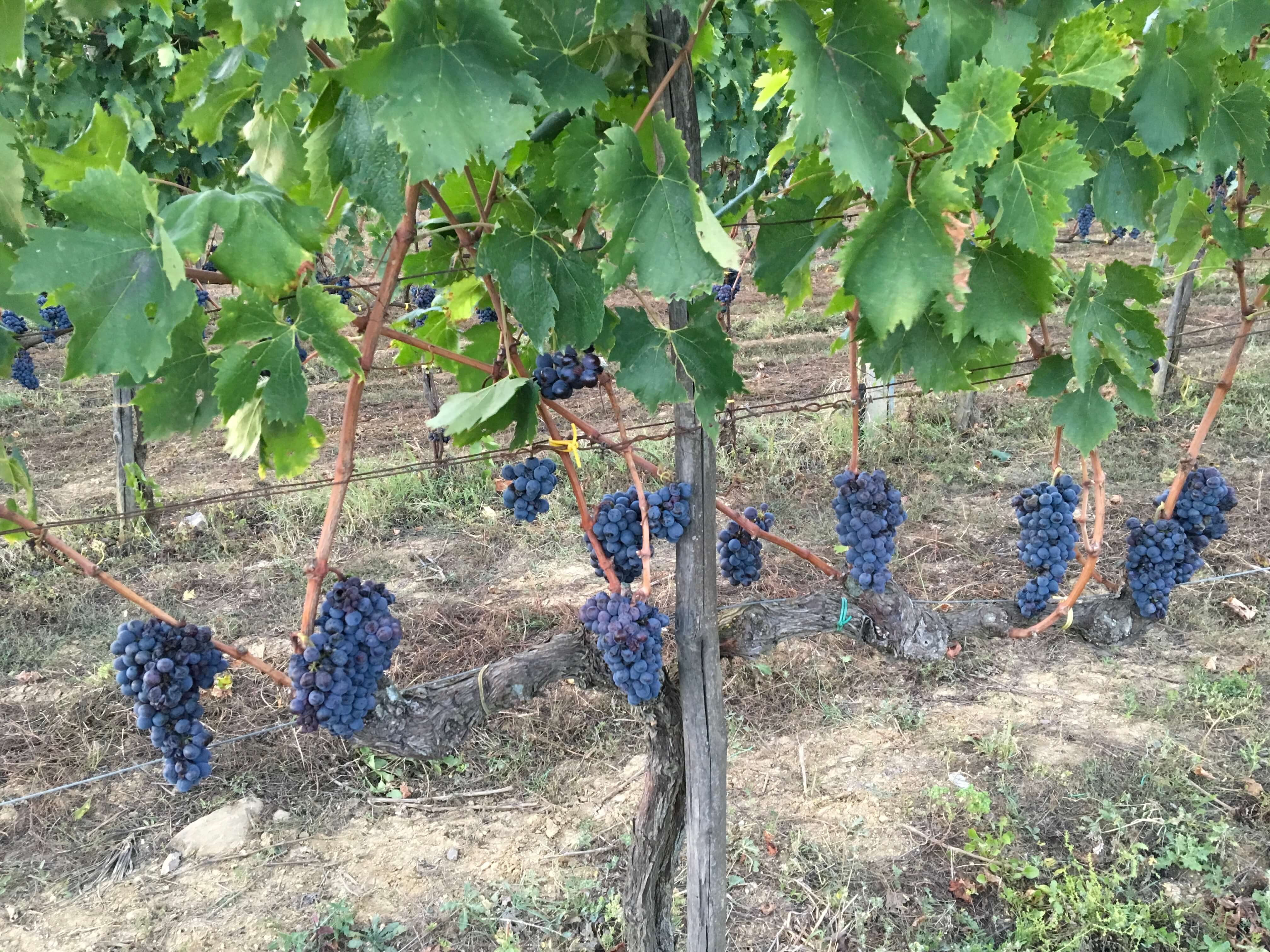
Remaining bunches after extreme selection at Soldera’s Case Basse in Montalcino
Unlike in 1989, the only year when Soldera didn’t make a wine because of too much rain, he was “ready for the challenge” this time round, and believes he will still make a great wine in 2018, albeit in very small quantities. For Soldera, rain is the enemy of vine-growing, and he rejoiced in the exceptionally dry growing season of 2017, “a year of fun”, where the vines drank mineral-rich water from the ground. Incidentally, the 2017, tasted (or rather drunk – as spitting is banned at Case Basse) from its Garbellotto cask, is incredible: alluring, alive, pure, and long.
The owner of neighbouring wineries Caparzo and Altesino, Elisabetta Gnudi puts 2018 somewhere between a four- and five-star vintage. To absorb the humidity, her team used clay dust on the vines, “like using baby powder,” she explained. Again echoing the story in Bordeaux, she reckons that “true organic vineyards haven’t harvested a single grape this year.”
At Argiano, Sales Manager Riccardo Bogi also described a less plain-sailing vintage than in Chianti. On top of the heavy rain, a hailstorm in July wiped out 25% of the crop in some vineyards. However, positioned high up on the hill of Argiano, wind in August meant the winery was able to counter rot with copper and sulphur, although the “agronomist didn’t get a vacation”, quipped Bogi. Like Heinz in Bolgheri, he expects 2018 to share characteristics with the elegant 2013s, saying they won’t have intense colour or structure.
There was a dramatic change in the weather on Monday, with temperatures dropping and strong winds picking up, which lasted throughout our three-day visit. While half of the appellation’s Sangiovese has already been harvested, and wineries are “happy with the quality,” Pondini hopes that, “the other half may benefit from this sunny, cool, windy week”.
As July begins, much of the wine world may feel more grey and drizzly than the weather would suggest, due to a case of post-primeurs blues. Indeed, Wine Lister’s founder, Ella Lister, reports in her recent article for JancisRobinson.com that “…the majority of merchants are reporting revenues down approximately two-thirds on 2016”. In that article, a comparison of Quality scores across recent vintages highlights the value proposition of the 2014 vintage. In this blog post we dig a bit deeper.
A few weeks into this year’s en primeur campaign releases, the Wine Lister team noticed a distinct pattern. With almost every new release, we sounded more and more like broken records, echoing that château X’s 2017 release price, while below the last two vintages, made the 2014 look like good value. While it has been pigeonholed as a good but not great vintage, 2014 achieved consistently high critics’ scores that imply its reputation should be better.
The chart below shows Bordeaux 2014 and 2017 average Quality scores by appellation, comparing 2014 three-month average prices with 2017 release prices.
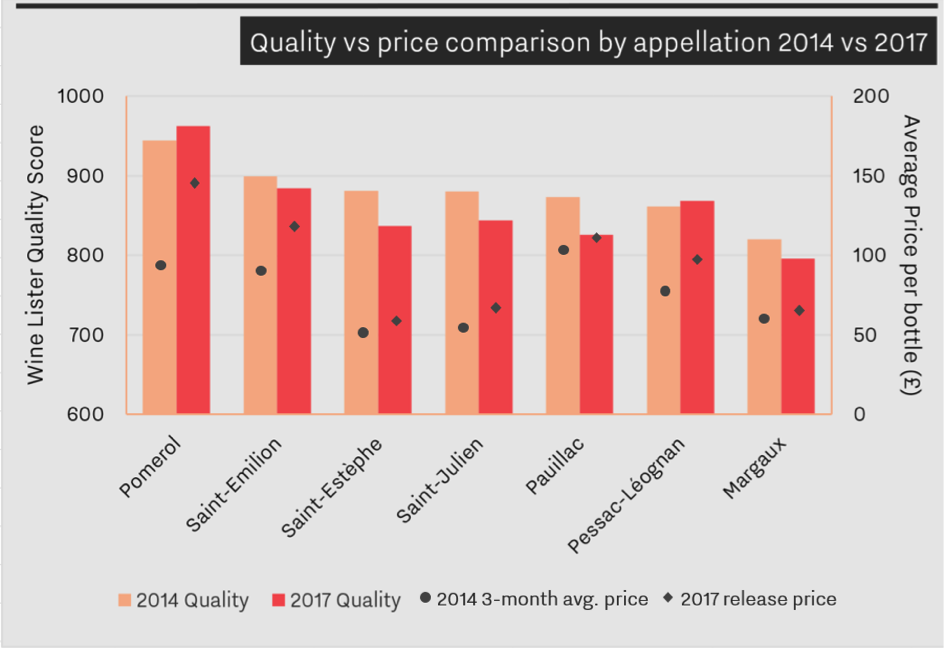
Based on 75 key Bordeaux classified growths, the chart illustrates the relationship between quality and price (note the price gap for 2014 and 2017 Saint-Émilion, despite similar average Quality scores). Only Pomerol and Pessac-Léognan achieved higher Quality scores on average in 2017 than in 2014, with Wine Lister’s partner critics preferring 2014 across all other appellations.
While the trade puts aside its allocations of 2017 for the time being, perhaps the silver lining is the light this vintage shines on relative value elsewhere. Is it time for merchants and collectors alike to focus on 2014?

We used Wine Lister’s comparison tool in our search for good-value back vintages in order to compare different vintages and their respective critics’ scores and prices. For example, Malescot Saint-Exupéry achieves a Quality score of 894 in 2014, versus 735 in 2017. Despite the substantial price reduction on the 2016 and 2015 vintages, the 2017 UK market price remains 5% higher than the 2014, the latter receiving higher scores from three of the four Wine Lister partner critics. Neal Martin disagrees, awarding the 2017 a potential 2 points more than 2014 saying, “it is not a complex Malescot St. Exupéry, but I admire the balance and focus”.
Malescot Saint-Exupéry 2014 has the highest Value Pick score of any recent vintage:
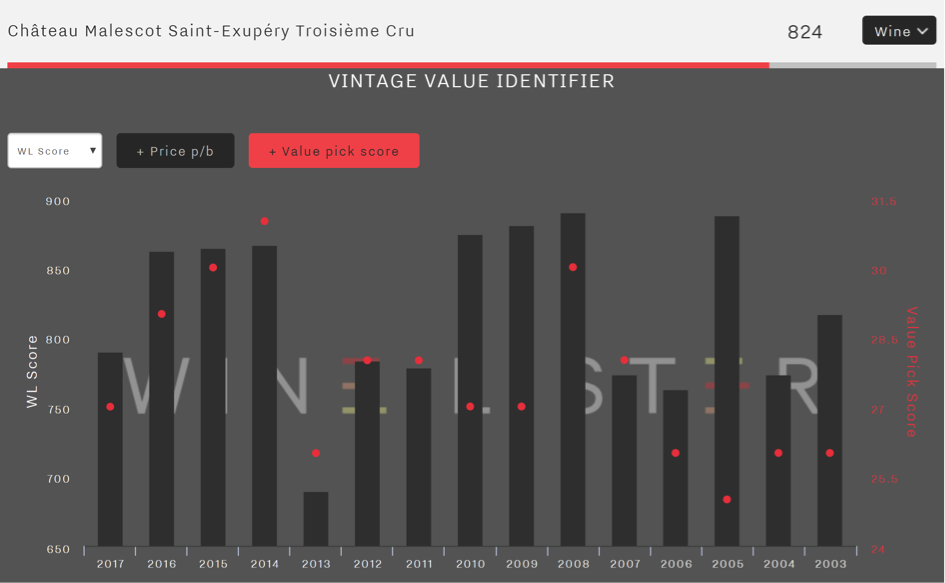
Use the Vintage Value Identifier chart (pictured above) on every wine page to pick out the best value back vintages. For example, Cantenac-Brown’s 2014 looks like a particularly good buy, at £25.50 per bottle for the 2014 (whose Quality score is 800), versus the 2017 at £34.05 per bottle, with a Quality score of 715. Its 2015 looks good too.
As a sort of postscript to the difficult 2017 en primeur campaign (read our CEO Ella’s thoughts here), over the past week or so Pomerol powerhouses Petrus and Le Pin were released at £1,480 and £1,750 per bottle respectively. With Pomerol wines achieving the top three Quality scores of all reds for 2017 – and five of the top 10 – it was the top-performing red appellation of the vintage.
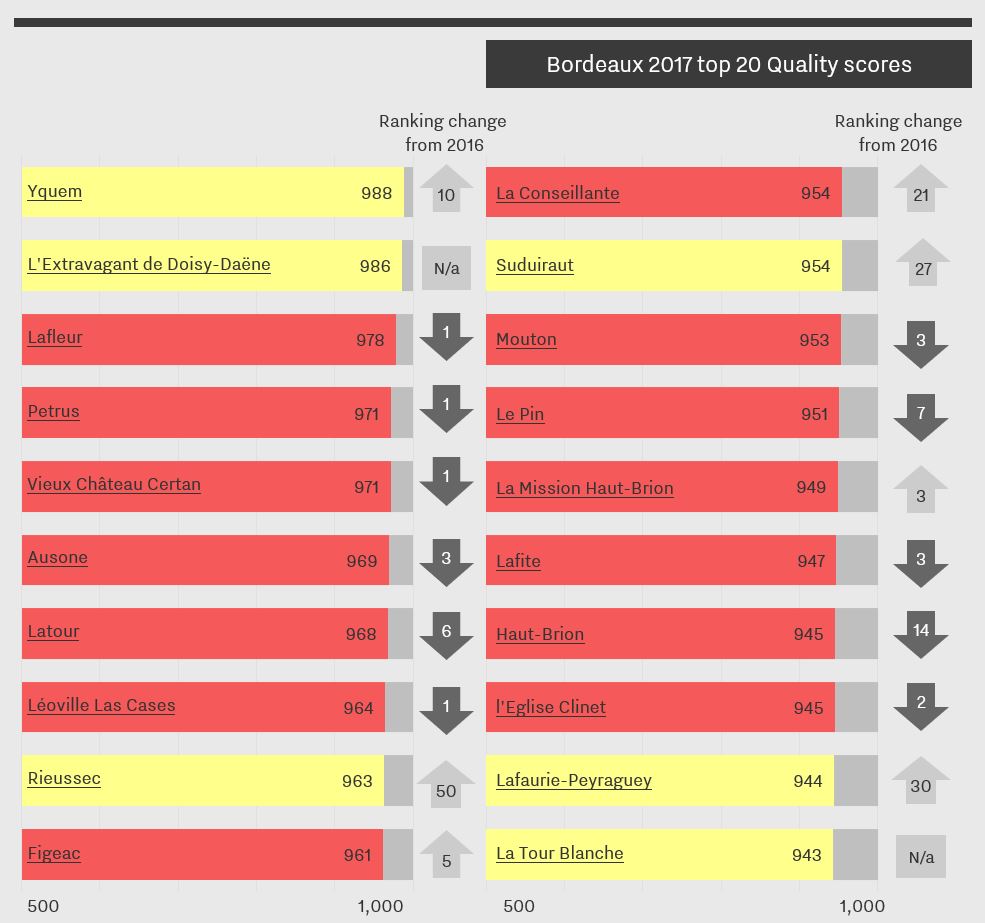
Now that we have release prices for all of Pomerol’s top wines, we can see which came out on top in terms of overall Wine Lister score*.
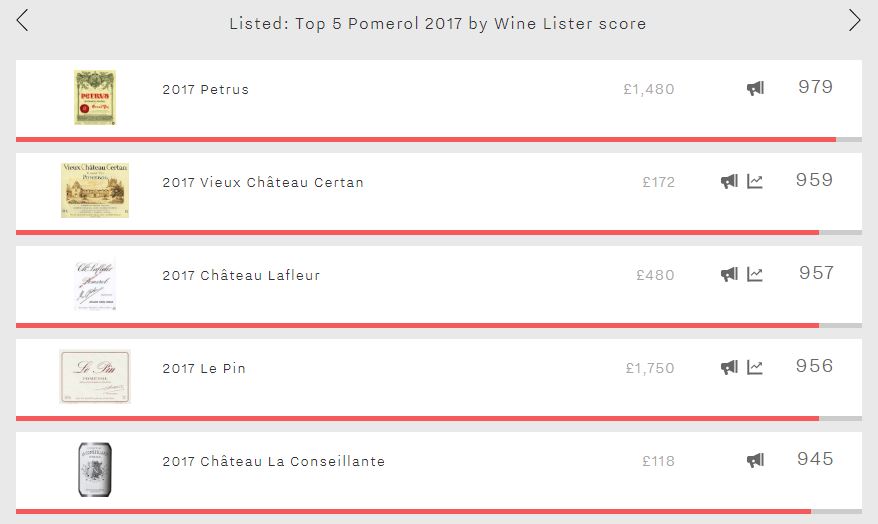
With a score of 979, Petrus was not just Pomerol’s leading wine of 2017, but the number one wine in Bordeaux. This is perhaps unsurprising given that it received the joint-second best Quality score of the vintage of all reds (971) – alongside Vieux Château Certan – and also has a Brand score of 998 (beaten only by Lafite, Latour, Mouton, Yquem, and Dom Pérignon Vintage Brut) along with a wine-level Economics score of 978 (third-best in Bordeaux). With Wine Lister’s Founding Members voting it the second-most prestigious wine in the world in a recent survey, behind DRC La Romanée-Conti, Petrus is currently unbeatable in Bordeaux.
Number two on the 2017 Pomerol leaderboard is Vieux Château Certan (959). While the confidence rating attributed by Wine Lister’s Founding Members slipped a point over the past year from 9/10 to 8/10, it nevertheless achieves Pomerol’s second-best Brand score (972). Thus, despite its relatively modest Economics score (909) – still putting it amongst the very best on Wine Lister’s 1,000 point scale – the 2017, thanks to its excellent Quality score, manages to edge just ahead of Lafleur in terms of overall Wine Lister score (957).
Lafleur 2017, the best red wine of the vintage for Quality (978), was released in early May at £430 per bottle, a 7% decrease on the 2016 release price. This was Neal Martin’s favourite of the five, Wine Lister’s newest partner critic awarding it a score of 95-97 /100 and commenting: “This is an awesome 2017 from Baptiste Guinaudeau, one of the few that will oblige several years in the cellar”.
Le Pin 2017 was released in the UK at £1,750 per bottle, its 25% decrease on the 2016 release price the largest year-on-year reduction of the five. It experiences the lowest Quality score of the five for the vintage (951), and also has the group’s lowest Brand score (944). The fact that the 2017 betters Lafleur and La Conseillante in terms of overall Wine Lister score is thus the result of its formidable Economics score (980), which it achieves not just because of its high average price but also strong growth rates, which are the best of the group over both the long and short-term.
Rounding out the group is La Conseillante (945). Whilst it is by far the most affordable of the group, it is the only one of the five whose 2017 climbed the Bordeaux Quality score table compared to 2016, surging 21 spots to be the eighth best red and 11th best overall.
Remember that you can catch up on all of the campaign’s releases on our dedicated en primeur page.
* Please note that overall Wine Lister scores for en primeur wines use estimated Economics scores based on the performance of back vintages.
Which producers will see the largest gain in brand recognition in the next two years? As part of our recent Bordeaux Market Study, we asked Wine Lister’s Founding Members – c.50 key members of the trade from the world’s largest merchants, top international wine auctioneers and several high-end retailers, together representing well over one third of global fine wine revenues.
While Burgundy achieved the largest number of producers mentioned at least once (50), all 10 of the most-cited producers hail from Bordeaux.
With the en primeur campaign finally in full swing, below are Bordeaux’s biggest rising stars: the region’s top 10 brands expected by Wine Lister Founding Members to see increased recognition in the next two years.

Château Canon received the highest number of votes for the brand likely to see most increased brand recognition over the coming two years, and is therefore the number one rising star in this year’s Bordeaux Study. Canon also achieves the joint-highest confidence rating from the trade (see last week’s blog for details), and appears in the top 10 wines for price performance after en primeur release .
In a show of strength by owner Chanel, another of its properties, Rauzan-Ségla, receives the second-highest number of votes, alongside Les Carmes Haut-Brion.
Haut-Batailley, recently acquired by the Cazes family – and having released no wine in 2016 – is seen as a brand with a bright future (and the new owners clearly think so too – it was released at a very ambitious price of £43 at the end of April).
Other Bordeaux wines voted likely to see the largest gains in brand recognition over the next two years are: Brane-Cantenac, Pavie, Calon Ségur, Figeac, Lafleur, and Pichon Comtesse.
Visit Wine Lister’s Analysis page to read the full report (available in both English and French). Go to p.24 to see how many votes each of the above wines received.
Bordeaux en primeur analysis of Branaire-Ducru 2017, which has been released this morning at €33.60 ex-négociant, 15% down on 2016 (€39.60 last year) and with a U.K. RRP of £34.25, 13% down on 2016.
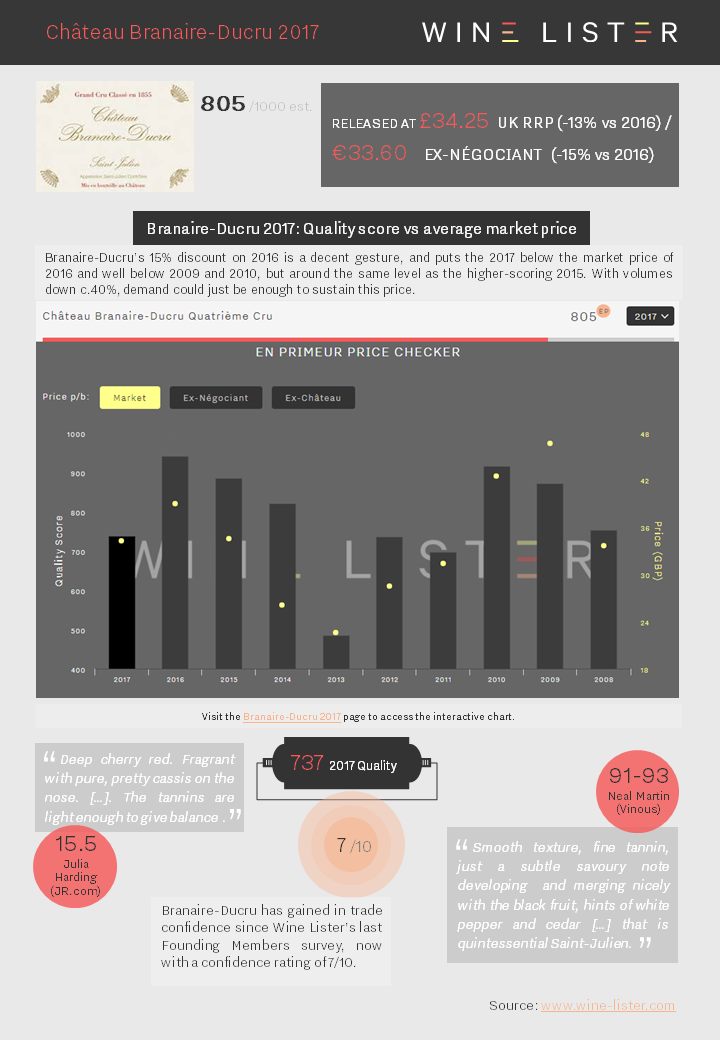
You can download the slide here: Wine Lister Factsheet Branaire-Ducru 2017.
Margaux’s Château Palmer made a surprise move on Monday morning, releasing its 2017 vintage en primeur before anybody expected. At €192 ex-négociant, its price decrease of 20% on the 2016 (€240) is symbolically significant.
For several years the château has only released 50% of its Grand Vin en primeur each year, which has allowed it to develop an aggressive pricing policy, positioning itself well above other third growths and even second growths. The wine’s price had risen 14% for the 2016 vintage, giving it some margin to come down again this year. This neatly places the 2017 between the 2014 and 2015, both in terms of original release prices and current market prices:
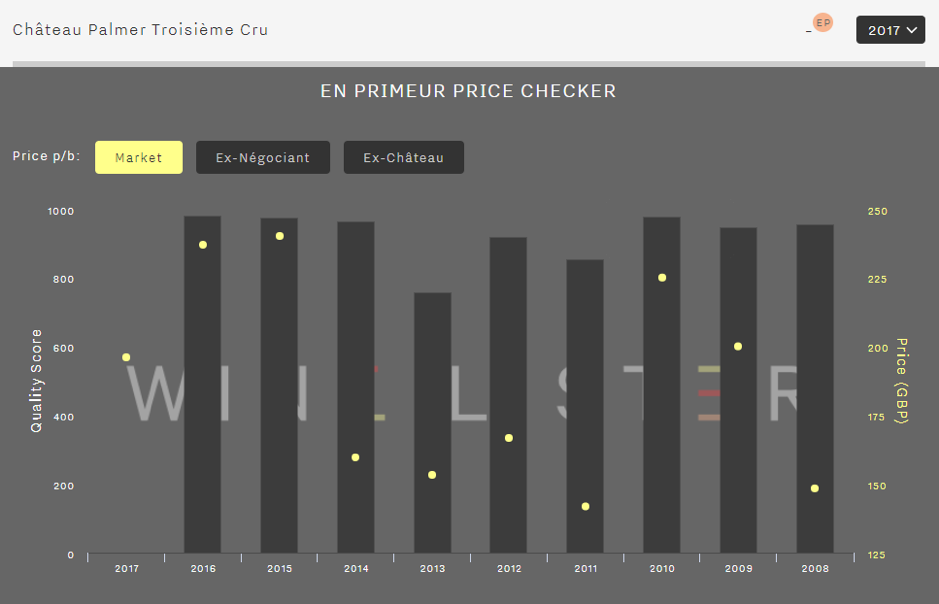
This was a smart and strategic move by Managing Director, Thomas Duroux. When we tasted at the château in the second week of April, he shared his thoughts on the campaign, and it was clear he had considered the dynamics of 2017 Bordeaux en primeur very carefully.
Duroux was cautious about the campaign, saying “It’s going to be complicated as there are lots of discouraging factors.” He believes it’s difficult to achieve three good campaigns in a row, and that there is not a huge amount of demand from consumers. He spoke of a confusion around price and volumes, explaining that “just because there’s less wine doesn’t mean consumers are ready to pay more – they don’t care.” As it happens, the Grand Vin was spared frost damage in April 2017, while 15ha of the second wine was hit. Alter Ego was released at just a 2% discount on the 2016.
“We risk having a campaign where prices go down but not enough to be judged attractive by the consumer,” warned Duroux. It remains to be seen whether Palmer 2017’s 20% decrease is enough. With the trade unprepared, and scores not out yet for many important wine critics (including Wine Lister’s partner critics), it is now a waiting game. Négociants have bought their allocations, and for now they are holding a fair amount of stock of Palmer 2017 in Bordeaux.
Sales by UK merchants are modest for the time being. Depending on scores that will be released over the coming 10 days, Palmer might start to seem like a good deal, particularly when (not if) the discounts start to shrink over the course of the campaign. Or indeed when the discounts become premiums, as we saw this morning with the release of Haut-Batailley 2017 – read the blog post here).
Wine Lister uses data from our partner, Wine-Searcher, to examine wines with increasing online popularity on a monthly basis.
This month, Château Canon sees a 7% increase in search frequency for January-March 2018 from the previous period. As predicted by our Founding Members (c.50 key members of the fine wine trade), who voted Château Canon number one wine likely to gain the most brand recognition in the next two years in the 2017 Bordeaux Market study, Canon was one of the big successes of last year’s en primeur campaign. Its brand continues to go from strength to strength, with search frequency in 2017 rising 35% between January and October. It will be interesting to see whether this year’s en primeur release has the same impact on its online search frequency as the 2016 vintage.

Two cult Californian wines are among the top five for latest search frequency increases.
Scarecrow saw an increased search frequency of 52% for January-March 2018 compared to the previous period thanks to its latest release in February. The 2015 vintage is as yet unscored by Wine Lister partner critics, however the estate has seen consistent Quality scores between 996-987 since 2010.
Screaming Eagle also makes the top five wines with biggest search frequency increase this month. With 17,831 average monthly searches between January and March 2018, the increase is small relative to its already vast online popularity. Indeed, Screaming Eagle remains the number one most searched for Californian wine on Wine-Searcher.
Burgundy is represented in the top search increases by Marquis d’Angerville, whose Volnay Premier Cru Taillepieds saw double its average number of monthly searches in January-March 2018 compared with the previous period. Guillaume Angerville eschews the scrum of the January Burgundy en primeur tastings in London, preferring to showcase his new vintage each March with a small tasting and lunch – the Taillepieds obviously made an impression, and achieves its highest ever Quality score (969).
Finally, searches for Azienda Agricola Falletto’s Barolo Rocche Falletto Riserva continue to rise into March following the sad passing of Piedmont legend, Bruno Giacosa. The wine saw a bittersweet rise in popularity of 14% in December 2017-February 2018, which continues at a slightly slower pace (10%).
Wine Lister Economics scores not only reflect a fine wine’s economic clout, but also predict its future price performance. The economics of fine wine are increasingly important. Some purists wish it weren’t the case (wouldn’t it be wonderful if quality could exist in isolation from pecuniary concerns?), but consider the plight of the producer making an exceptional wine, that without any brand recognition or commercial strategy doesn’t ever see the light of day. It never finds an importer, or its way into the consumer’s glass, let alone the investor’s portfolio.
That is why Wine Lister scores capture 12 data points across three rating categories, to measure the all-round performance of a fine wine in its journey from vine to glass. After Quality and Brand, the third Wine Lister rating category is Economics. The Economics score shows the producer whether its commercial strategy is working, but more than that, it can also serve to indicate to the collector whether the wine makes an economically sound investment.
Bordeaux wines with an Economics score above 900 in November 2016 had increased by 17% in price on average by January 2018. By contrast, those with Economics scores below 600 gained just 8% subsequently. We can see this pattern in action in the chart below, which looks at Saint-Estèphe wines over the same 14-month period. The wines with the highest Economics scores at the beginning of the period proceeded to increase more in price than those with lower scores as a general rule.
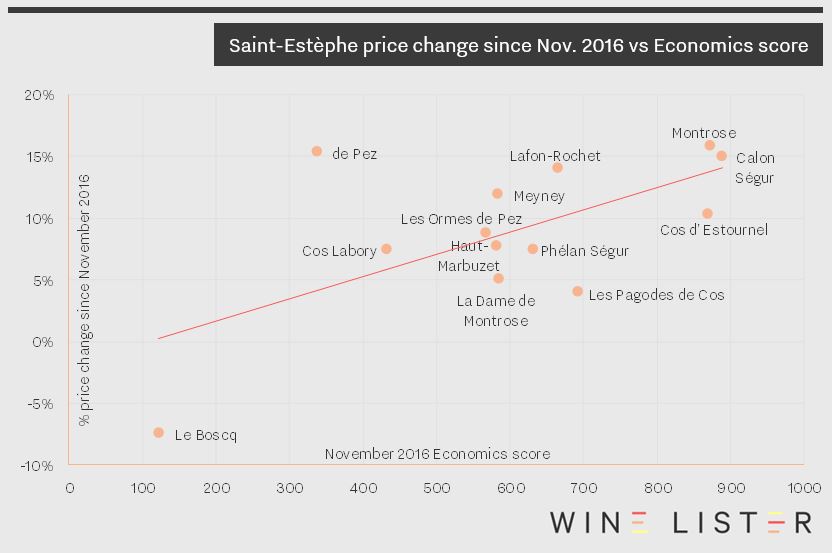
The below screenshots of Wine Lister’s price history tool illustrate graphically the difference between two wines with different economic profiles. Vieux Château Certan’s Economics score lies in the “strongest” portion of the Wine Lister 1000-point scale at 907/1000. While Château La Providence’s Quality score is strong (708/1000) its low Economics score of 389 is the result of a lower price, weak price performance, volatile prices, and modest trading volumes.
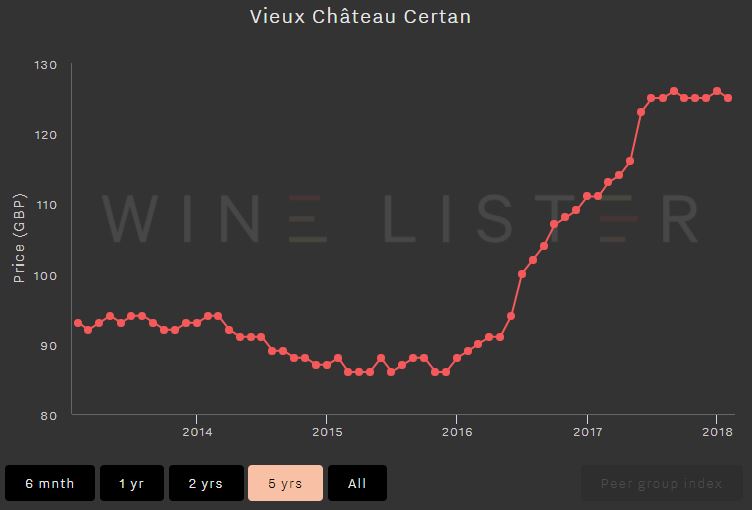
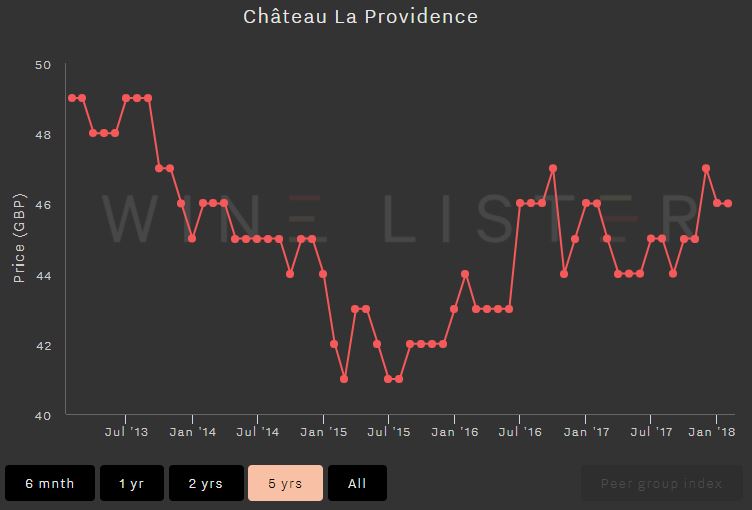
Wine Lister analyses five criteria in order to measure a wine’s economic strength, expressed as an Economics score out of 1,000. Four of these criteria use pricing data from our data partner, Wine Owners, while the fifth uses trading volume figures from the Wine Market Journal:
- 3 month average bottle price
This “market price” is the ultimate measure of what people are willing to pay for each wine in each vintage. Data is updated weekly, and bases prices on a three-month rolling average. Prices are shown In Bond per bottle.
- Short-term price performance
A wine’s financial strength also depends on its price performance. Wine Lister calculates price changes over six months for an indication of short-term price trends.
- Long-term price performance
Long-term performance measures a wine’s compound annual growth rate over three years.
- Price stability
Price fluctuations over a 12-month period are distilled into the measure of a wine’s stability. Wines with less volatility are more consistent, less risky and therefore earn a better Economics score.
- Volume traded
Added to pricing information is data on a wine’s liquidity. A wine can have good price performance but lack the current market demand, potentially making it a less attractive wine for investment.
















